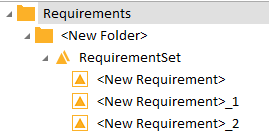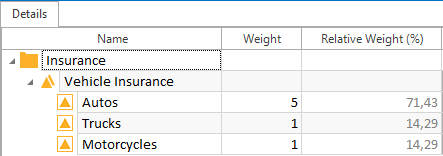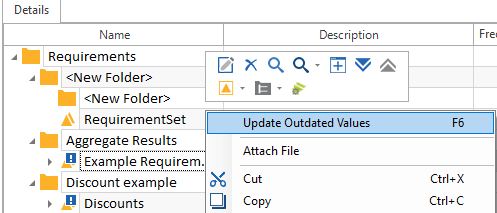Work with Requirements
The testing lifecycle begins by identifying the criteria which the system under test is expected to fulfill. In Tricentis Tosca, these are called Requirements.
Before creating a Requirement structure in Tricentis Tosca, work together with your stakeholders or business analysts to gather Requirement data and specify the testing criteria.
Requirements can be either:
-
Functional criteria, or functionalities the system under test must be able to carry out. An example of this is processing a webshop credit card order.
-
Non-functional criteria, or requirements of the system under test that are not strictly necessary for the system to function. An example of this is system security.
After you have gathered the necessary Requirement data for your system under test, you can begin building a Requirement structure in Tricentis Tosca.
Create a Requirement structure
Use the Requirements section to create a clear Requirement structure that reflects the criteria of your system under test, or your testing process. The basic elements of your Requirement structure are:
-
Requirements folders
-
RequirementSets
-
Requirements

Basic Requirement structure
To create a new Requirements folder, right-click on a folder in the Requirements section and select Create Folder from the mini toolbar.
Alternatively, click Create Folder in the Requirements dynamic ribbon menu, or use the shortcut Ctrl + N, Ctrl + F.
Folders can contain sub-folders. Within a folder, Requirements are organized in RequirementSets.
RequirementSets are containers that hold Requirements.
To create a RequirementSet, right-click on a Requirements folder and select Create Requirement Set from the mini toolbar.
Create Requirements
Every Requirement must be assigned to a RequirementSet. By default, the property RequirementType is Requirement. You can define and assign additional RequirementTypes if desired, but only administrators can change the assigned RequirementType after the Requirement has been created.
To create a Requirement, right-click on a RequirementSet and select Create Requirement from the mini toolbar.
If you have defined additional RequirementTypes, select the type you want to assign from the dropdown menu (see chapter "Create and assign RequirementTypes").

Create Requirement with the RequirementType Non-functional Requirement

|
You can rearrange your Requirement structure using drag and drop. |
Weight your Requirements
Some Requirements carry more business risk if they fail than others. For example, if a vehicle insurance company does most of its business selling automobile insurance and only some business selling truck and motorcycle insurance, they can weight their Requirements to reflect this.
Work together with your business analysts or stakeholders to determine Requirement weights.
When you create new Requirements, by default they all have a weight of 1. To change the weights, follow the steps below:
-
Select a RequirementSet and add the Weight column to the Details view (see chapter "Add or remove columns").
-
Click into the Weight input fields of the different Requirements and enter the new weights.
You can also add the Relative Weight (%) column to see what percent of the total weight each individual Requirement carries.

Requirement weights
Update Requirement values
When you create a new RequirementSet or Requirement, or anytime you make changes to TestCases that are linked to the Requirements section, you need to update the Requirement values.
You can either tell Tricentis Tosca to do this automatically, or you can trigger updates manually.
By default, the setting AutoCalculateRequirements is turned Off. This means that you need to manually trigger the update of Requirement values.
Anytime you make a change to a RequirementSet, or to a TestCase that is linked to a RequirementSet, a blue exclamation mark on the RequirementSet icon ![]() indicates that values need to be updated.
indicates that values need to be updated.
To trigger a specific update calculation, right-click the RequirementSet and select Update Outdated Values from the context menu.
To update all outdated values at once, select![]() Update Outdated Values from the dynamic menu Requirements.
Update Outdated Values from the dynamic menu Requirements.

Update Requirement values manually
Update values automatically
You can also configure Tricentis Tosca to automatically update values in the Requirements section.
To do so, enable the setting AutoCalculateRequirements under Project->Settings->Commander->General->Advanced.
Restart Tricentis Tosca for your changes to take effect.

AutoCalculateRequirements in Settings dialog
Tricentis Tosca synchronizes changes and automatically updates values in the Requirements section.

|
Enabling the AutoCalculateRequirements setting can result in considerable wait times in large repositories. |